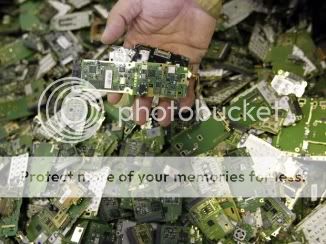Interesting Article, Good Year AheadBattling China’s rare earth metals monopoly

REUTERS
A man works at the site of a rare earth metals mine at Nancheng county, Jiangxi province in China on October 20, 2010
Comments Twitter LinkedIn Digg Buzz Email Jonathan Ratner October 25, 2010 – 6:48 am
Only a decade ago, China represented less than 10% of global copper consumption. That number is expected to climb above 40% this year or next as massive infrastructure
investment, and now domestic consumption, is the target of government stimulus.
This expansion of personal consumption in China and other emerging markets, coupled with the technology boom, means more demand for things like cell phones, LED screens, high-efficiency lighting, electric car batteries and wind turbines. And that is translating into a greater need for rare and specialty metals.
If base metals are things like aluminum, copper, lead nickel and zinc, then specialty metals include rare earth elements such as cobalt, niobium, tantalum, vanadium and many other somewhat obscure metals that now make the world go ‘round. Their unique physical, optical, magnetic and other properties make rare earths essential (and without substitute) for a multitude of advanced applications. Which is why recent comments out of the Chinese Ministry of Commerce that the country would cut its quotas for rare earth exports by as much as 30% next year are getting so much attention.
An official said China wants to protect the metals from over-exploitation as the country faces the possibility of some reserves running dry within 15 to 20 years at current production rates. However, China denied the reports and said it “will continue to supply rare earth to the world.”
China has a virtual monopoly on production, owing to a decades-old recognition of the strategic nature of rare earths by Deng Xiaoping. The industry was the target of huge amounts of subsidized
loans in the mid-1980s in an effort to promote social stability through employment. That resulted in the creation of small mining operations specializing in rare earths.
Production rates climbed by an average of 40% annually in the 1980s, according to U.S.-based global security consultancy Stratfor. They then doubled in the first half of the 1990s, only to double again with a big increase in output just as the world entered recession in 2000. Naturally, prices nose-dived.
But with a seemingly endless supply of below-market loans, it didn’t matter that most Chinese firms weren’t making money. A recent report from Stratfor explains that continued Chinese production forced the closure of nearly every other rare earth producer and allowed the information technology revolution to take root.
Despite the current landscape, rare earths are rather abundant globally. In fact, before China made a major effort to mass produce rare earth elements in 1979, there were several major suppliers. The United States was the largest producer, while Australia, Brazil, India, Malaysia and Russia all had meaningful production.
As a result, the idea of a long-term monopoly appears unsustainable. The problem is a lack of economic deposits in low sovereign risk areas, according to analysts at Canaccord Genuity. “Low-cost production, often without regard for environmental impacts, allowed China to knock out competitors globally,” they said in a report.
Little concern on the part of end-user corporations and nations enabled China to achieve its goal. Now it is limiting exports in order to focus on its own value-added finish product manufacturing. China also wants to build its own strategic stockpile that is reportedly as large as 200,000 tonnes.
Premier Wen Jiabao happens to have studied rare earth research for years. He has suggested that some countries have built and maintain strategic stockpiles, acquired at the expense of China during its weaker economic times.

Toru Hanai/REUTERS
A worker holds parts of a scrap mobile phone, at a recycling facility of Re-Tem Corp, in Tokyo. The company researches and develops the recycling of rare earth metals vital to the production of electronics. Japanese high-tech companies face higher input costs for rare earth metals as dominant supplier China curbs exports.
So when a Chinese fishing vessel collided with two Japanese patrol boats in disputed waters back in September, a diplomatic scuffle broke out. Japanese traders and consumers started reporting difficulty sourcing rare earth materials from China.
China denies any rare earth export ban, but it does produce roughly 95% of global supply and Japan is the largest importer, according to Stratfor. As a result of the ongoing spat between China and Japan, as well as China’s racheting down of export quotas by an average of 12% annually over the past five years, rare earth prices have tripled so far in 2010.
Fears that China could shut down its exports have prompted a number of actions by corporations and governments. For example, the U.S. House of Representatives recently passed the Rare Earth and Critical Materials Revitalization Act of 2010, while a second act, the Rare Earth Supply-Chain Technology and Resource Transformation Act, has been introduced in Congress. Japan has also issued an extensive rare earth policy designed to fast-track development and enhance recycling.
Canaccord expects non-Chinese corporations and government-controlled entities will continue to partner and acquire rare earth projects. For example, Japan recently signed an agreement with Mongolia and Sumitomo, along with a joint venture with Kazakhstan, and is expected to expand its partnership with Vietnam shortly.
So while the rare earth play is relatively new, it is getting a lot of attention these days, particularly given the apparent non-official embargo.
“Japan and other producers of magnets, motors and monitors will not tolerate the suffocation of their industries, and world powers like the U.S. and Europe will not allow their defence industries – also heavy users of rare earths – to be compromised by export restrictions,” Canaccord said.
As a result, expect these players to become very aggressive in the next year as rare earth projects are advanced.
Jonathan Ratner